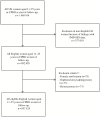Chlamydia trachomatis and the Risk of Pelvic Inflammatory Disease, Ectopic Pregnancy, and Female Infertility: A Retrospective Cohort Study Among Primary Care Patients
- PMID: 31504315
- PMCID: PMC6792126
- DOI: 10.1093/cid/ciz429
Chlamydia trachomatis and the Risk of Pelvic Inflammatory Disease, Ectopic Pregnancy, and Female Infertility: A Retrospective Cohort Study Among Primary Care Patients
Erratum in
-
Erratum to: Chlamydia trachomatis and the Risk of Pelvic Inflammatory Disease, Ectopic Pregnancy, and Female Infertility: A Retrospective Cohort Study Among Primary Care Patients.Clin Infect Dis. 2020 May 23;70(11):2459. doi: 10.1093/cid/ciz897. Clin Infect Dis. 2020. PMID: 31535123 Free PMC article. No abstract available.
Abstract
Background: We evaluated the risk of pelvic inflammatory disease (PID), ectopic pregnancy, and infertility in women with a previous Chlamydia trachomatis (CT) diagnosis compared with women who tested negative for CT and CT untested women, considering both targeted and incidental (ie, prescribed for another indication) use of CT-effective antibiotics.
Methods: This was a retrospective study of women aged 12-25 years at start of follow-up within the Clinical Practice Research Datalink GOLD database linked to index of multiple deprivation quintiles, 2000-2013. CT test status and antibiotic use were determined in a time-dependent manner. Risk of PID, ectopic pregnancy, or female infertility were evaluated using of Cox proportional hazard models.
Results: We studied 857 324 women, contributing 6 457 060 person-years. Compared with women who tested CT-negative, women who tested CT-positive had an increased risk of PID (adjusted hazard ratio [aHR], 2.36; 95% confidence interval [CI], 2.01-2.79), ectopic pregnancy (aHR, 1.87; 95% CI, 1.38-2.54), and infertility (aHR, 1.85; 95% CI, 1.27-2.68). The PID risk was higher for women with 2 or more positive CT tests than those with 1 positive test. PID risk increased with the number of previous antibiotic prescriptions, regardless of CT test status.
Conclusions: We showed an association between CT-positive tests and 3 adverse reproductive health outcomes. Moreover, this risk increased with repeat CT infections. CT-effective antibiotic use showed no decreased risks of subsequent PID regardless of CT history. Our results confirm the reproductive health burden of CT, which requires adequate public health interventions.
Keywords: Chlamydia trachomatis; CPRD; adverse reproductive health; antibiotics.
© The Author(s) 2019. Published by Oxford University Press for the Infectious Diseases Society of America.
Figures


References
-
- Haggerty CL, Gottlieb SL, Taylor BD, Low N, Xu F, Ness RB. Risk of sequelae after Chlamydia trachomatis genital infection in women. J Infect Dis 2010; 201(Suppl 2):S134–55. - PubMed
-
- Davies B, Turner KME, Frølund M, et al. ; Danish Chlamydia Study Group Risk of reproductive complications following chlamydia testing: a population-based retrospective cohort study in Denmark. Lancet Infect Dis 2016; 16:1057–64. - PubMed
-
- Reekie J, Donovan B, Guy R, et al. ; Chlamydia and Reproductive Health Outcome Investigators Risk of pelvic inflammatory disease in relation to chlamydia and gonorrhea testing, repeat testing, and positivity: a population-based cohort study. Clin Infect Dis 2018; 66:437–43. - PubMed
Publication types
MeSH terms
Substances
LinkOut - more resources
Full Text Sources
Medical

